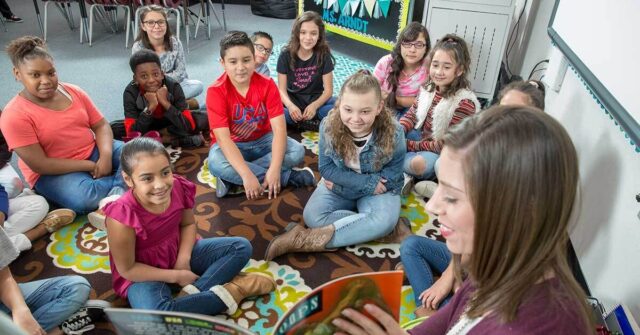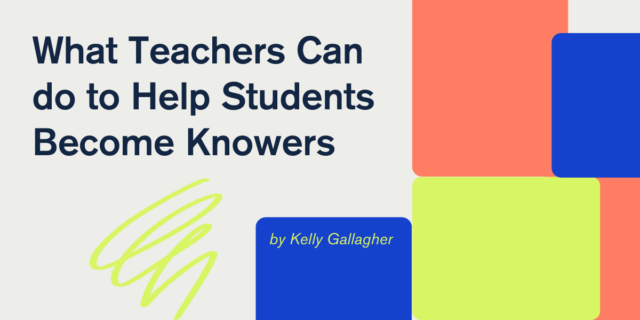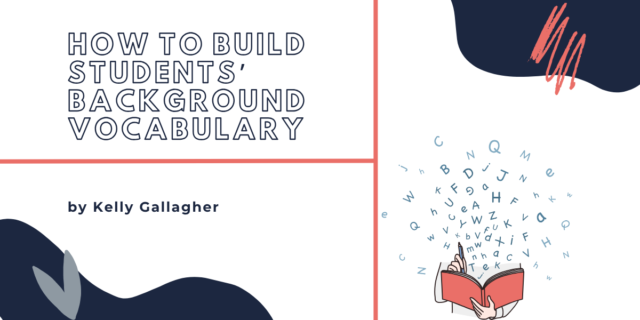
The following is an adapted excerpt from Kelly Gallagher’s To Read Stuff You Need to Know Stuff.
***
Today, when I hear people say curriculum has become political, I respond by saying curriculum has always been political. “All curriculum?” I have been asked. “What about math? How can numbers be political?”
I answer by suggesting that how we count and what we count is very political. (I am reminded of the saying “There are three types of lies: lies, damn lies, and statistics.”) It would not take more than a minute or two to find an example online of how numbers are manipulated. When I google “How are statistics manipulated?” there are over twenty-eight million responses.
So, yes, all curriculum.
What Should We Teach?
I wrestled with a 100 percent–mandated reading curriculum early in my career. Back then, all English teachers in my district were required to teach the same core novels and plays chosen from a short list of canonical titles written primarily by white, male authors. No choice. No deviation. Any suggestion of revising the list to include diverse and contemporary books was met with fierce opposition by the old guard, who saw these proposals as a blasphemous watering down of the curriculum. The Scarlet Letter would have to be pried from their cold, dead fingers. Over time, however, this rigidness began to thaw, largely driven by student indifference and disengagement. But it was also directed by a small group of teachers who saw the mandated list as a form of hegemony, that this disengagement was largely centered on a curriculum that ignored the rich cultural backgrounds of our students, and, worse, that this disengagement ensured that these students would remain marginalized.
My students were largely Latinx, and the mandated tenth-grade curriculum required them to read Lord of the Flies, Fahrenheit 451, A Separate Peace, To Kill a Mockingbird, and Farewell to Manzanar. With this imbalance in mind, I proposed that the district adopt Rudolpho Anaya’s Bless Me, Ultima. (I wanted to pair it with To Kill a Mockingbird, as both books explore big ideas: racism, justice, coming of age, morality.) Yes, adding Bless Me, Ultima meant subtracting one of the entrenched titles, but I knew my students would connect culturally to the richness of Anaya’s novel. This was a small compromise, which the district eventually agreed to.
Flash forward thirty years, and my students read a wide range of writers across numerous cultures (as evidenced by some of the selections mentioned in the last chapter). Instead of reading six major literary works in lockstep, my students and I read two core texts together—one each semester. There is a value in reading a core text together—a value not found when reading individually or in small groups. The rest of the year, they were free to select books they wanted to read (either independently or in book clubs) because there is also a value that arises when students develop allegiances to authors they have chosen. Both of these values can be true.
5 Big Ideas for Curricula:
The Curriculum Should Arise from a Collaborative Process
As more diverse voices attain ever more forms of reach and power we need to re-integrate and reimagine Hirsch’s list of what literate Americans ought to know. What we teach should be decided by diverse voices of stakeholders. We might start by having teachers in each content area list ten things every student should know in each course. Through a process of aggregation and discussion, eventually a crowd-sourced list of what we should teach could emerge. We should use this same process to decide what we want students to read. Doing so would surely raise some interesting questions: What should the balance be between shorter pieces (articles, short stories) and full-length books? What should be the ratio of fiction to nonfiction? And maybe most importantly, whom should students be reading?
The Curriculum Should be Balanced and Structured
One of the negative effects of the Common Core State Standards is that the testing overvalued ELA and math classes while undervaluing other content areas. As a result, less time was devoted to teaching topics other than language arts and math. One way of ensuring we achieve balance is by making sure a structure reading curriculum is in place. By ‘structure,’ I am not advocating that English teachers teach the same page of the same chapter of the same novel on the same day. Rather, teachers (and students) should have a map of when and where they are going. Learn more about reading maps in 180 Days.
The Curriculum Should Strike a Balance Between Depth and Breadth
To learn something deeply means spending more time on a topic or subject. But spending more time on a topic or subject also means students will spend less time on the curriculum as a whole. The answer lies in the middle. Hirsch advocates for a curriculum that teaches a diversity of topics (science, history, ethics, literature, and the arts), not just the formal skills of reading, writing, and arithmetic. In doing so, “we should also teach in some depth a moderate number of specific examples” (2001). When applied to the reading curriculum, this means students should be reading assignments like the article of the week while also reading books. Our first goal is to get students to get into reading lanes, and once they have established some momentum as readers, it is time to guide them into other reading lanes.
The Curriculum Should be Tuned In—A Living, Breathing Thing
What do I mean by having a curriculum that is tuned in to our students? It is not uncommon, for example, for students in English classes to write one literary analysis essay after another—this despite the fact that only 2.8 percent of college students are English majors (Phelps 2023). This is the opposite of being tuned in. As Penny Kittle and I have argued (2022), wouldn’t it be better to remove one of these essays and replace it with a digital composition? Shouldn’t we honor the expertise students bring with them to class? On the reading side, wouldn’t it be better to update the reading lists so students have access to diverse, high-interest books? If a core text is too difficult for most of the students in the clas, should we just plow forward and continue teaching it simply because that is the way it has always been? What is in the best interest of the students?
The Curriculum is More Than Meets the Eye
The word curriculum as it is defined from its early Latin origins means literally “to run a course.” But given the complexity of schools today, that definition seems too narrow. I like Tom Vander Ark’s idea that curriculum is “a sequence of mental, physical and emotional experiences. That definition keeps the focus on the experience of the learner” (2017). These mental, physical, and emotional experiences go far beyond any single lesson or unit plan. Everyday contacts are critical. This is why I greeted my students at the door every day. This is why I had boxes of energy bars and other snacks in the back of my classroom for my students to freely access. This is why the first thing you noticed when walking into my room was the extent of my classroom library. All part of the curriculum. All helpful in advancing learning.
***

To Read Stuff You Have to Know Stuff Now Available!


